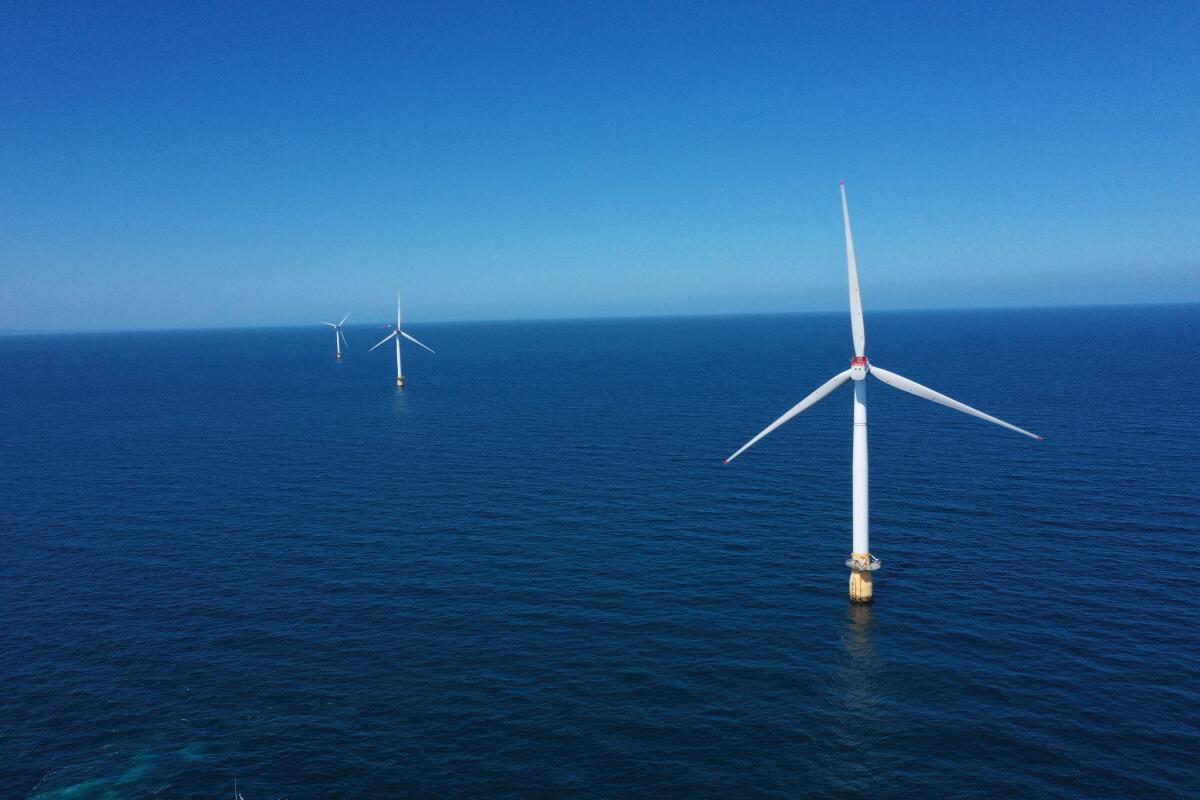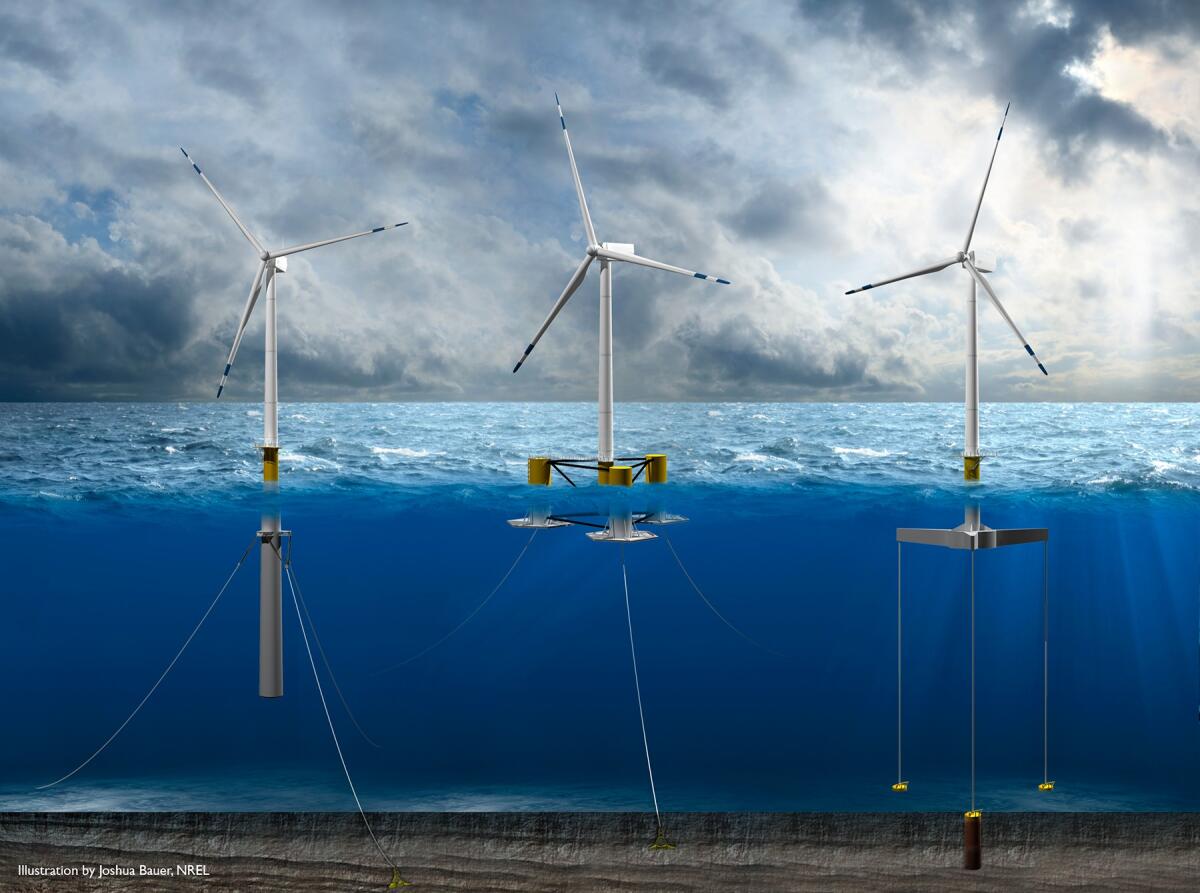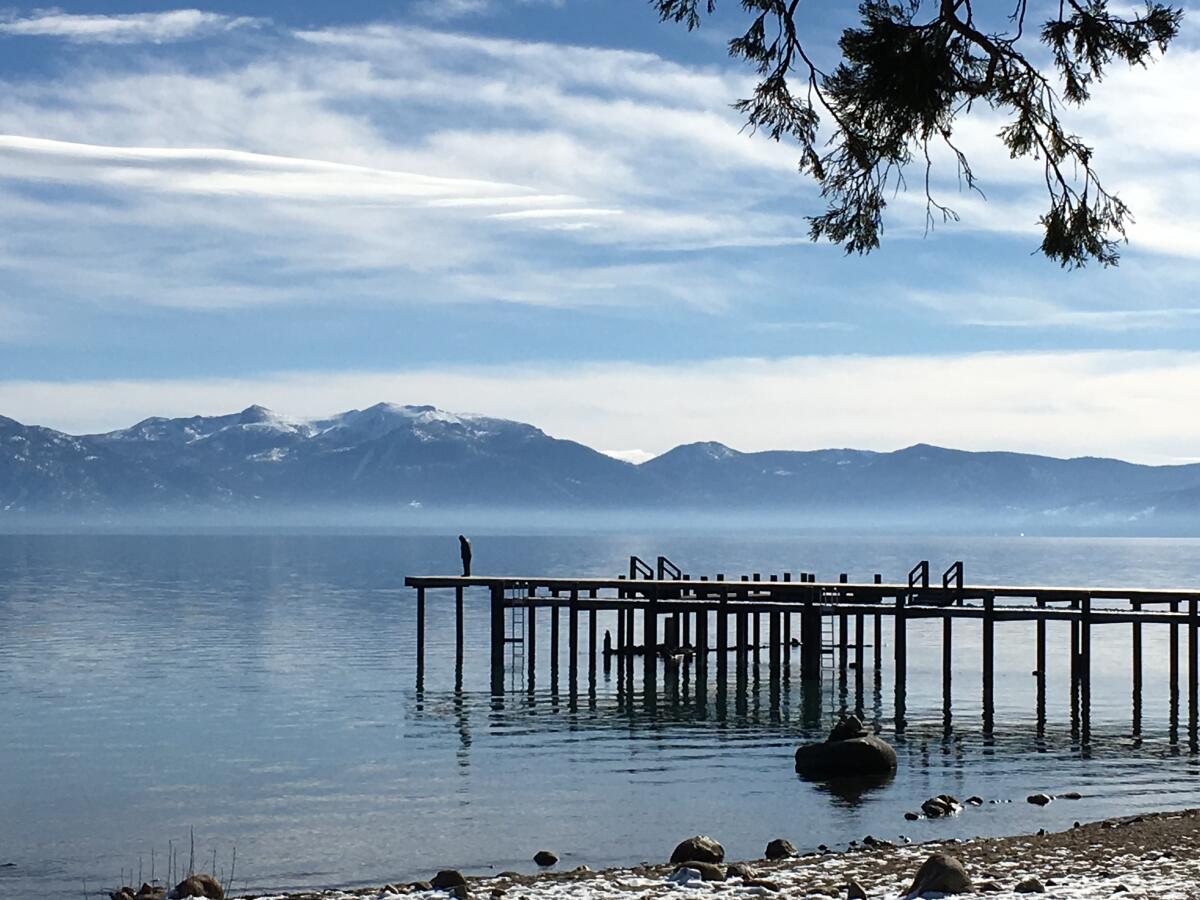What offshore wind power could mean for California (when turbines eventually start spinning)

- Share via
Good morning, and welcome to the Essential California newsletter. It’s Thursday, Jan. 12. I’m Ryan Fonseca.
The Pacific Ocean contains a potential windfall of clean, renewable energy. Last month, the federal government took a major step to harness that power.
The Bureau of Ocean Energy Management auctioned off five lease areas covering more than 373,000 acres in Central and Northern California. The Northern California area includes two parcels off Eureka in Humboldt County and three in the waters west of Morro Bay in San Luis Obispo County. Both areas are about 20 miles offshore.
The five winning companies — one American and four European — bid more than $757 million in total for the rights to build wind farms in the Pacific parcels.
The state and local governments are banking on offshore wind to help reach their renewable energy goals in the coming decades. California aims to generate 2,000 to 5,000 megawatts of offshore wind by 2030 and 25,000 by 2045. That would be “enough electricity to power 3.75 million initially and 25 million homes by mid-century,” according to the California Energy Commission.
According to the Bureau of Ocean Energy Management, the newly auctioned parcels have “the potential to produce over 4.6 gigawatts of offshore wind energy, enough to power over 1.5 million homes.”
If you’re like me and Marty McFly, you’re probably wondering: What the hell is a gigawatt?
Arne Jacobson helped me out: One gigawatt is a billion watts.
He’s the director of the Schatz Energy Research Center at Cal Poly Humboldt, which promotes and studies clean, renewable energy technologies. I spoke with him this week to better understand what these wind turbines would do and when they might start spinning.
For Jacobson, the push for offshore wind “is really thinking about mitigation of climate change and how do we decarbonize our energy system.”
As for how many turbines these farms would have, Jacobson said that depends on the region and the power generation capacity of each turbine.
The parcels off Humboldt County could end up with around 100 to 150 turbines if fully built out, he said. The area off Morro Bay could be about double that.
Here are four other key takeaways from our conversation.
1. Harnessing wind power in the Pacific has some unique challenges
There’s a lot of wind out at sea to spin turbines and generate power, but the windiest areas are above deep water — too deep for fixed-bottom turbines, which attach to the ocean floor. These West Coast wind farms will need to float, secured with a series of anchors and mooring lines.
The vast majority of offshore turbines in operation are fixed to the ocean floor, Jacobson said, so floating turbines are in an earlier stage of technological development.
“California is certainly not as far along as some parts of the East Coast when it comes to offshore wind,” he said. “But I think we’re in some ways ahead of the game when it comes to thinking about floating offshore wind.”
Offshore turbines are also much larger than their land-based relatives. Jacobson said the expectation is that offshore turbines would be about 600 feet up to the main hub and around 900 feet tall when adding the blades.
A bigger turbine means more power generation. Offshore turbine capacity is expected to hit 12 to 15 megawatts, while land-based turbines typically generate three or four megawatts.

2. We’ll need a whole lot more infrastructure (and money)
The biggest challenges facing offshore wind in California, according to Jacobson:
- “A fairly significant investment in transmission infrastructure” to be able to handle all the power the wind farms would generate.
- Large-scale construction of new port infrastructure to handle the assembly and transportation of turbines from land to the open ocean.
California’s power system is not prepared to absorb and transmit the billions of watts floating turbines would generate. That’s especially true in northwest California, which has a “weak” grid, Jacobson said. Getting the state’s power infrastructure up to speed will take some time, he explained:
“Large transmission projects take a decade or sometimes longer. ... To build out at scale, I think it’ll be into the early 2030s, or maybe as [long] as 2035, probably before the transmission infrastructure is ready to be able to absorb that power.”
The other issue is building and shipping the turbines out to sea. That requires unique port conditions. For example, ports in San Francisco Bay won’t work because the turbines would be too tall to fit under the Golden Gate Bridge.
3. The environmental effects remain largely unknown
Relatively new technology is at play and the effect floating wind farms could have on marine ecosystems is unclear.
Like land-based turbines, bird strikes remain a concern. Jacobson noted that some marine birds that rely on ocean wind for “dynamic soaring,” such as albatrosses, could be at risk.
But “it’s hard to know how some of these seabirds will interact with wind farms when there aren’t wind farms,” he said. “Having an initial project in water will really help to be able to understand what the issues are.”
Researchers like Jacobson are also mindful of how wind farms might affect deep-sea fisheries, as well as “upwelling,” a process that brings colder water and plankton to the surface. That creates ocean grazing grounds that support a vast ecosystem of marine life.
Wind plays a big role in that process, and Jacobson explained that “early modeling” indicates wind farms could potentially affect upwelling.
“If you have a very large wind farm, you’re essentially slowing down the wind downstream,” he said. “There’s definitely additional analysis needed there and it’s important to pay attention to that because obviously we can’t disrupt the food chain in any significant way.”
4. The timeline is very much TBD
Jacobson said the areas off Morro Bay, which has a stronger power grid than the Humboldt County area, will probably start getting turbines out first. But realistically, they won’t produce significant power until “the end of this decade.”
“We have to do a lot and we have to do a lot pretty quickly in order to meet those goals,” Jacobson said.
Another complication — but an important one: taking the time to ensure that smaller, marginalized communities are included in the process.
“People don’t want to just feel like big projects are being built to serve the needs of more populated parts of the state without significant benefits flowing through this region as well,” Jacobson said. “People know how to oppose things, and we have to figure out how do we get to yes on these things — and fast.”
I asked Jacobson if he’s optimistic that California can achieve its renewable energy goals as state and federal leaders look to mitigate the climate crisis.
“The technologies that are needed to do all of this exist, so that makes me optimistic,” he said, adding:
“It’s really about making sure that we have the economic resources and the political will to deploy them and to deploy them in a way that makes people trust that the power is going to stay on.”
And now, here’s what’s happening across California:
Note: Some of the sites we link to may limit the number of stories you can access without subscribing.
L.A. STORIES
Oil companies are suing the city of L.A. over its recent law to phase out drilling. In a pair of lawsuits, five oil companies are seeking to keep their operations going. Under the ordinance approved by L.A. leaders last month, new oil and gas extraction is banned immediately and existing production must stop within 20 years. Los Angeles Times
Check out "The Times" podcast for essential news and more
These days, waking up to current events can be, well, daunting. If you’re seeking a more balanced news diet, “The Times” podcast is for you. Gustavo Arellano, along with a diverse set of reporters from the award-winning L.A. Times newsroom, delivers the most interesting stories from the Los Angeles Times every Monday, Wednesday and Friday. Listen and subscribe wherever you get your podcasts.
POLITICS AND GOVERNMENT
The Internal Revenue Service is giving Californians effected by recent storms extra time to file this year. The agency announced that taxpayers in any county covered by a federal emergency declaration have until May 15 to file their income tax returns for 2022. Los Angeles Times
Gov. Gavin Newsom’s slimmed-down budget includes the overdose reversal drug naloxone for middle and high schools while largely avoiding cuts. The administration’s proposed education spending plan would sustain school budgets but mostly ends a recent expansion of K-12 and college funding. Los Angeles Times
A massive computer outage grounded flights across the U.S. early Wednesday, leading to thousands of delays. Southern California airports fared a little better than other parts of the country, since the system failure happened in the early morning hours, when flight activity drops off. President Biden said he’s directed the Department of Transportation to investigate the outage. Los Angeles Times
Some California hospitals are struggling to meet an earthquake safety deadline. Under a law passed after the 1994 Northridge earthquake, hospitals have to upgrade or replace their structures according to new safety standards. Some administrators are requesting deadline extensions, but labor groups argue the hospitals have had decades to comply. CalMatters
Support our journalism
HEALTH AND THE ENVIRONMENT
Californians are still reeling from the “parade” of storm systems that flooded streets, knocked down trees, caused mudslides and led to more devastation across the state. The latest reporting puts the death toll at 19. Los Angeles Times
CALIFORNIA CULTURE

In lighter storm news, California’s ski resorts are now flush with powder. Mammoth Mountain got up to 54 inches of snow from the last storm alone. Palisades Tahoe has received roughly 8.5 feet of snow so far this year (and more is on the way). Los Angeles Times
The West Coast burger staple In-N-Out is heading east. Company officials announced this week that they plan to open new locations in Tennessee in 2026, along with a new regional hub office near Nashville. Free tip for Tennesseans: Ask for those fries well-done. Los Angeles Times
Free online games
Get our free daily crossword puzzle, sudoku, word search and arcade games in our new game center at latimes.com/games.
CALIFORNIA ALMANAC
Los Angeles: mostly sunny, 68. San Diego: mostly sunny, 69. San Francisco: chance of rain, 62. San Jose: mostly cloudy, 64. Fresno: fog then mostly cloudy, 61. Sacramento: mostly cloudy, 61.
AND FINALLY
It’s been great to see the growing number of California landmarks that you’ve shared with us and what they mean to you. Keep them coming!
Today’s landmark love: Lake Tahoe, submitted by Jane Castruccio of Pleasanton.

Jane writes:
This photo was taken at Sugar Pine Point State Park on the west shore of Lake Tahoe. Our family has been going to Tahoe every year for the last 50 years. There is no other lake like it in all of the country and can be enjoyed year-round.
What are California’s essential landmarks? Fill out this form to send us your photos of a special spot in California — natural or human-made. Tell us why it’s interesting and what makes it a symbol of life in the Golden State. Please be sure to include only photos taken directly by you. Your submission could be featured in a future edition of the newsletter.
Please let us know what we can do to make this newsletter more useful to you. Send comments to [email protected].
Sign up for Essential California
The most important California stories and recommendations in your inbox every morning.
You may occasionally receive promotional content from the Los Angeles Times.




